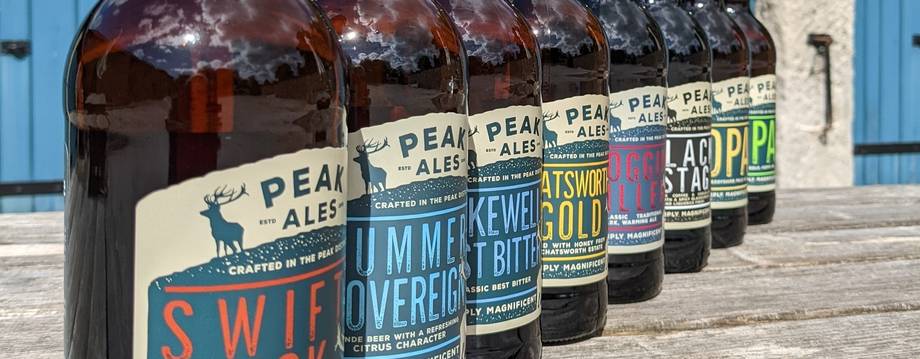On the map: Bakewell and the Peak District
Colin Drury's monthly tour of the UK’s lesser-known beer hotspots continues in the rugged Derbyshire uplands
Colin Drury
Saturday 17 December 2022

This article is from
Ones to Watch
issue 86
Share this article
It is a story which, legend has it, begins in a bath.
In 2005, shortly after Sheffield entrepreneur-done-good Jim Harrison bought a Peak District stately home, he and friend Simon Webster brewed a beer in one of the tubs there.
So good was it that the pair, so the tale goes, decided to install a 10-barrel kit in an outbuilding and start their own brewery.
They named that first drink after a previous owner of the hall: Lord Marples. They named the brewery after the 12th century pile itself: Thornbridge.
Thus started the story of one of the UK’s most successful independent beer-makers – and, perhaps too, the story of how the Peak District became one of the UK’s unlikely ale hot spots.
From giants like Thornbridge, Peak Ales and Buxton Brewery to smaller outfits such as Intrepid, Torrside and Dovedale – alongside micropubs like the Newsroom and the Joiners Arms – it feels like there’s barely a patch of this Derbyshire upland that is not home to incredible booze.
Making good beer, whatever people might have you believe, is a simple process
And, for many, Thornbridge itself – already well known to Ferment readers – sits at its heart.
From that humble 10-barrel kit, the company has transformed into the self-proclaimed Godfather of UK craft beer: today it pumps out 210,000 pints a week from a sprawling purpose-built site just outside Bakewell, sending it off across the world. Just last week, a drinker from New Zealand visited the hanger-style tap room here. He wanted to see the place that made his beloved Jaipur – oft-called England’s first craft IPA.
“I think you could argue that Jaipur transformed the entire UK beer scene,” says Liam Cullen, taproom supervisor and host of the Thornbridge Experience Brewery Tour. “Before that British beer was pretty bland. Jaipur was the disrupter that showed there was a thirst for something different.”

Holme Bridge, Bakewell © Peter Barr (CC BY-SA 2.0)
Either way, geography has always been important here: an early company motto proclaimed their beer “inspired by the Peak District”. So, what is it about this rugged countryside – generally more famed for sheep and cyclists than booze – that has inspired so many breweries over the last 15 years?
Cullen ponders this. “It’s very scenic,” he decides. “Very motivating.”
Gervaise Dawson has a rather more curious answer.
He runs nearby Eyam Brewery in the famed plague village, but before the former project consultant set up as a beer-maker in 2017, he and wife Tracy ran a bottle shop in the grounds of the 17th century Eyam Hall. It’s USP was selling beers made in the Peak District to tourists from around the country.
We hope that a small piece of the Peak District goes with our beers no matter where theyíre consumed
“We moved from London in 2011 and couldn’t believe how many amazing breweries there were that had almost zero exposure,” the 47-year-old explains. “We wanted to give them a shop window, literally.”
So, why does he think his adopted home has seen such a brewing boom? Because of the intriguing history and geography here, he reckons.
“Making good beer, whatever people might have you believe, is a simple process,” he says. “So what a brewery needs to stand out is a good story. Well, the Peak District is full of those – legends, myths, history, interesting places – and you’ll find a lot of breweries tap into that.”
Such as his own, indeed, where the beer names always riff on plague mythology. A pint of Ring O Roses, anyone? A half of Black Death stout? “Those stories are an open goal,” says Dawson. “They market themselves.”
Both multi-award-winning Peak Ales on the Chatsworth Estate and Buxton Brewery offer good examples of this too. The former has one beer named after the region’s most iconic stately home (Chatsworth Gold) and another named after the historic market town Bakewell (Bakewell Best), while the latter has a host of drinks that honour the rugged landscape: the Nine Stones NEIPA, the Whetstone IPA, and the Quercus DDH hazy pale, for instance.

PHOTO: Peak Ales
"We opened the brewery in 2005 creating traditional ales that lend themselves to the area. We love to produce Chatsworth Gold as it's a delightful Golden Ale made with honey from the Chatsworth Estate just a mile down the road. The key ingredient Chatsworth honey balances the notes of the hops and is definitely our biggest seller both in pubs and shops around the area," says Robert Evans, the founder of Peak Ales.
“We have unrivalled local scenery so it feels right deriving names from the location,” says Ben Shaw, head of sales at Buxton which first opened its doors in 2009 and now produces a range of 30 ales. “We hope that a small piece of the Peak District goes with our beers no matter where they’re consumed.”
One place where they are sometimes consumed, in fact, is The Joiners Arms. This was the first micropub in the region when it opened in Bakewell in 2019 – although it has since been joined in what would be a spectacular pub crawl (or, rather, spectacular pub bus ride) by places such as The Ale Shop in Buxton and The Newsroom in Matlock.
“We would never stock a beer just because of its geography,” says Chris Sinclair, owner of the Joiners. “But we do end up putting on a lot of local beers, like Eyam, just because they’re doing such interesting stuff. It’s a bit of a paradise here for that.”
Share this article
